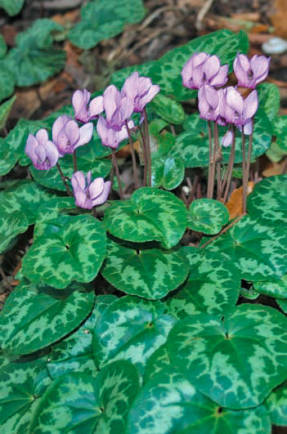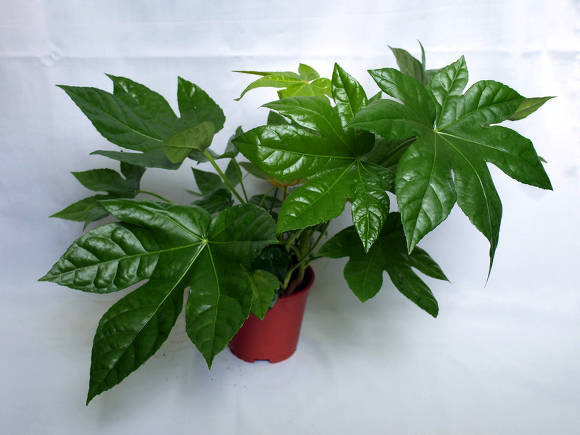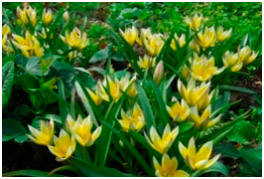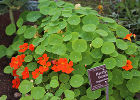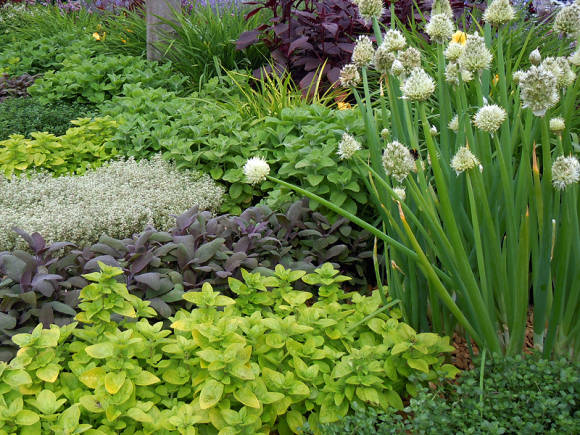 |
| Rosa Morden Blush is the most profusely flowering variety from the Parkland series, excellent choice for planting on flower beds in an array |
The roses that grow successfully in the northern regions come from species that have managed to adapt to difficult winter conditions. They have developed a natural ability to resist hypothermia. And although a large number of varieties of roses are quite winter-hardy, only a few of them can be called truly frost-hardy - these include Canadian roses.
The most important species for hybridization can be distinguished - wrinkled rose (Rosa rugosa). This species comes from Northern China and Japan and has amazing winter hardiness. The popular hybrid tea roses come from the species r. Chinese (Rosa chinensis), growing naturally in southern China: plants of this species have not developed the ability to withstand frost.
For a century, Canadian breeders have developed plants that survive and thrive in harsh climates. The first rose Agnes was bred in 1900. Not so long ago, the research centers of the Department of Agriculture in Manitoba and Quebec released a series of very stable hybrids - Explorer Rose (Explorer roses) and Parkland rose (Parkland roses). According to the classification, they belong to the group of scrubs - modern park roses. These hybrids can withstand temperatures as low as -35 ° C in the presence of snow, are disease resistant, bloom again and are easy to grow in the snowy Canadian winters. Series Parkland different from the series Explorer lower bushes.
Canadian frost-resistant roses are of great interest for our climatic zone as well. Most require minimal pruning and grow easily from green cuttings. Own-rooted roses are most often found on sale, and when, under borderline weather conditions, the shoots nevertheless freeze out, they resume their growth from the roots.
Roses Explorer grown in Ottawa and tested in Ottawa and Quebec. Rose series Explorer, named after outstanding Canadian explorers, are distinguished primarily by their high winter hardiness. Many varieties in this series were derived from the wrinkled rose and a subgroup of climbing roses named after the breeder Cortez. These include varieties Alexander MacKenzie, Captain Samuel Holland, Champlain, Charles Albanel, David Thompson, Henry Hudson, Jens Munk, John Cabot, John Davis, Martin Frobisher, Nicolas, Royal Edward, William Booth.
Popular varieties of the series Parkland – Adelaide Hoodless, Cuthbert Grant, Morden Blush, Morden Cardinette, Morden Centennial, Morden Ruby, Morden Sunrise, Winnepeg Parks.
 |
| Rose Morden Blush - lush flowers consist of 52 petals and change color from light pink to cold the weather is white in the heat |
All roses of the series Parkland and Explorer grow well in milder climates. Under these conditions, they grow much taller than in cold climates, but sometimes they are not as resistant to disease. These varieties have revolutionized rose growing not only in Canada and the northern states of the United States, but also in Scandinavia and Central Europe. Now these roses have also come to Russia.
Most of the varieties that the main producers of rose seedlings combine in a series of stable, relatively unpretentious varieties belong to the group of scrubs and in the conditions of Russia confirm all our expectations. These roses do not get sick and grow well with a simple level of agricultural technology, from which you can create rose gardens with minimal maintenance.
The place of the rose in the garden is the key to successful growth
The area for self-rooted roses should be located in a well-lit place. If the roses are in the shade most of the time, then they stretch out, bloom poorly, the bushes weaken, and the dew on the leaves that does not dry out for a long time contributes to fungal diseases.
The site must be protected from winds that harm the plants by constant swaying and dehydration of the leaves. The shoots of roses bend in the wind, sometimes break, their roots loosen, and this can lead to damage to the bush. But at the same time, planting roses require constant air circulation, especially in conditions of excessive moisture. Also, avoid planting roses under large trees and bushes or in low flooded areas where cold air stagnates.
It is very important that the site has good drainage: groundwater should not rise above 1–1.5 m.Roses are very sensitive to wet soils - if their roots are in water for a long time, they rot and die from lack of oxygen.
Soil preparation
For self-rooted roses, cultivated loamy and light clay soils, rich in humus and water and air permeable, are suitable. Swampy soils are completely unsuitable for roses. In areas with heavy clay soil, drainage is done, sand, humus, compost, peat are added. Light sandy soils are improved by adding sod or compost soil, organic fertilizers. The reaction of the soil should be slightly acidic (pH 5.5–6.5). Under these conditions, the rose makes the best use of the elements available in the soil. On more acidic soils, lime should be applied (500 g / m²).
Roses are planted for a long time and therefore the depth of the fertile layer should be at least 40-50 cm (2 bayonets of a shovel). Since most roots develop near the soil surface, where they receive more oxygen and nutrients, it is better to apply organic matter (up to 30 kg / m² of manure, humus or peat compost) to the upper soil layers. The planting soil mixture consists of 2 parts of garden soil, 2 parts of organic fertilizers (manure, humus or peat compost) and 1 part of sand. Bone meal, wood ash can be added to the finished mixture.
If the stocks of compost are small, then it is better to add it completely to the planting pit. Planting holes are dug just before planting roses, their depth and diameter depends on the size of the bush and roots. Usually the depth of the pit is 30 cm, the width is 50 cm. Nutrient planting soil mixture can be added to the planting hole. It is undesirable to apply mineral fertilizers, it is better to let the plants take root first.
Planting own-rooted roses
Container roses can be planted from May to August. The self-rooted roses planted in spring (at the beginning of May) in containers are preliminarily kept in partial shade for 7 days. Before planting, the shoots are pruned to 10-12 cm, leaving 2-3 buds and removing the leaves, since the planted plants are not able to provide the supply of juices to a large number of buds until complete rooting, and the leaves turn yellow and fall off from the change of place and temperature, and the plant harder to take root. When a seedling with a closed root system is planted, they try to keep a clod of earth around the roots, for which they water the container pot abundantly. At the same time, a hole is dug twice as wide and a little deeper than the container, planted 2-3 cm deeper than they were in the pots, spud, watered and shaded from direct sunlight. It is necessary to ensure that the soil does not dry out during the period of plant survival - slowly moving into growth or dried plants must be watered vigorously.
Formation of bushes
 |
| Rose Champlain - in each inflorescence up to 30 velvety red flowers with a subtle fleur fresh aroma |
2-3 weeks after spring planting, young, healthy and properly planted plants take root and begin to form shoots. Along with the growth of side shoots, the root system also grows. It is necessary to carefully observe the plants and, as necessary, regulate the growth of individual shoots in order to form a symmetrical bush.
For uniform development of the crown (especially in young plants), formation is carried out, for which young shoots, which are ahead of others in development, are pinched when the 4th leaf appears. Pinching promotes the emergence and development of new shoots, and this allows you to form a bush with several symmetrically developed shoots. In August, the formation can be stopped and the young plant can be allowed to bloom.
Watering
Roses need to be watered as the soil dries up - with insufficient watering, the growth of shoots stops, they wither, the flowers become smaller, the foliage falls off.It is necessary to water the roses rarely, but abundantly (up to 10 liters of water per bush), preferably in the morning - then the moisture on the leaves will have time to evaporate by the evening and will not provoke the appearance of fungal diseases. Roses in winter dormancy must leave with an undried root system, otherwise the probability of their death is high.
Own-rooted roses, which have a fibrous root system, need more frequent watering on hot days. They should be watered with a gentle stream, trying not to wash out the roots, but it is best to use a sprinkler with a sprayer. By autumn, watering is reduced so as not to expose roses to the danger of developing fungal diseases. As a preventive measure in the fight against fungal diseases in the fall, all plants should be treated with a 1-3% solution of Bordeaux liquid or nitrophene. At the end of September, watering is finally stopped - at this time there is an accumulation of nutrients and ripening of wood, which contributes to a good wintering of self-rooted roses.
Top dressing
Roses are very responsive to fertilization. In the first year after planting, young bushes do not need mineral fertilizing, if a good filling of the soil has been carried out. They can only be fed with liquid organic fertilizers. Mullein infusion is prepared at the rate - 1 part of manure to 10 parts of water, insist it for 5-8 days, stirring occasionally. The solution is ready for use after the release of bubbles has ceased. Poultry manure is a more concentrated organic fertilizer, and therefore 1 part is used for 20 parts of water.
With a lack of nitrogen, young leaves become small, pale green, and fall off prematurely. with a deficiency of phosphorus - the leaves are dark green, purple-reddish below. If there is little potassium, young leaves turn red, turn brown and fall off, the flowers become smaller. micronutrient deficiencies are reflected in the upper leaves. lack of iron and manganese can cause chlorosis of young middle and upper leaves. with a lack of boron, young shoots and buds die off, the edges of the leaves are bent down. lack of copper makes the leaves sluggish.
In the spring, after pruning and before the leaves bloom, you can fertilize with ammonium nitrate - 30–40 g / m². Two weeks later, fertilizing with nitrogen fertilizers is repeated: nitrogen affects the growth of shoots, leaves, roots, increasing the weight of the plant. In subsequent years, you can carry out up to 6-7 fertilizing with organic and mineral fertilizers.

